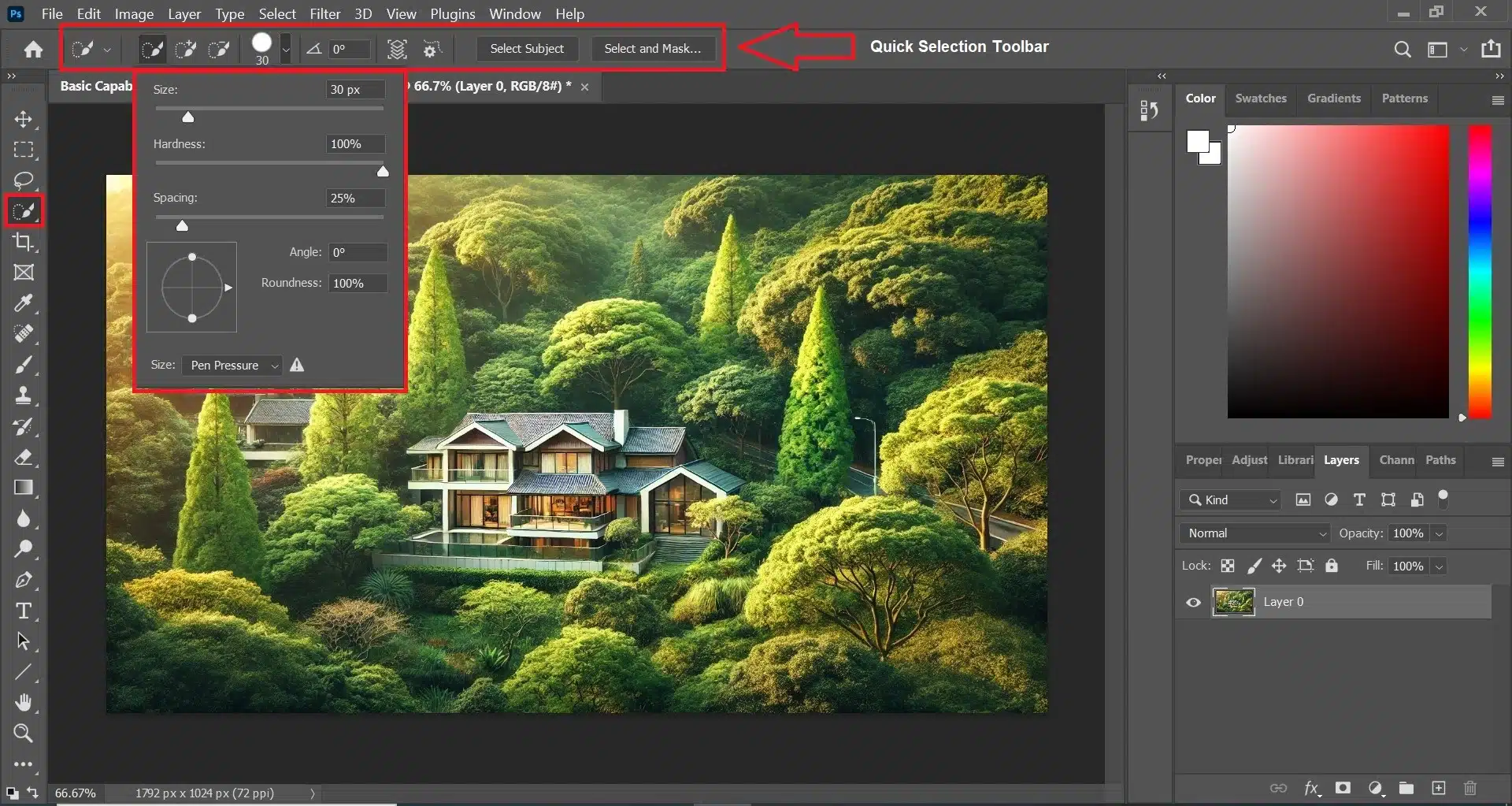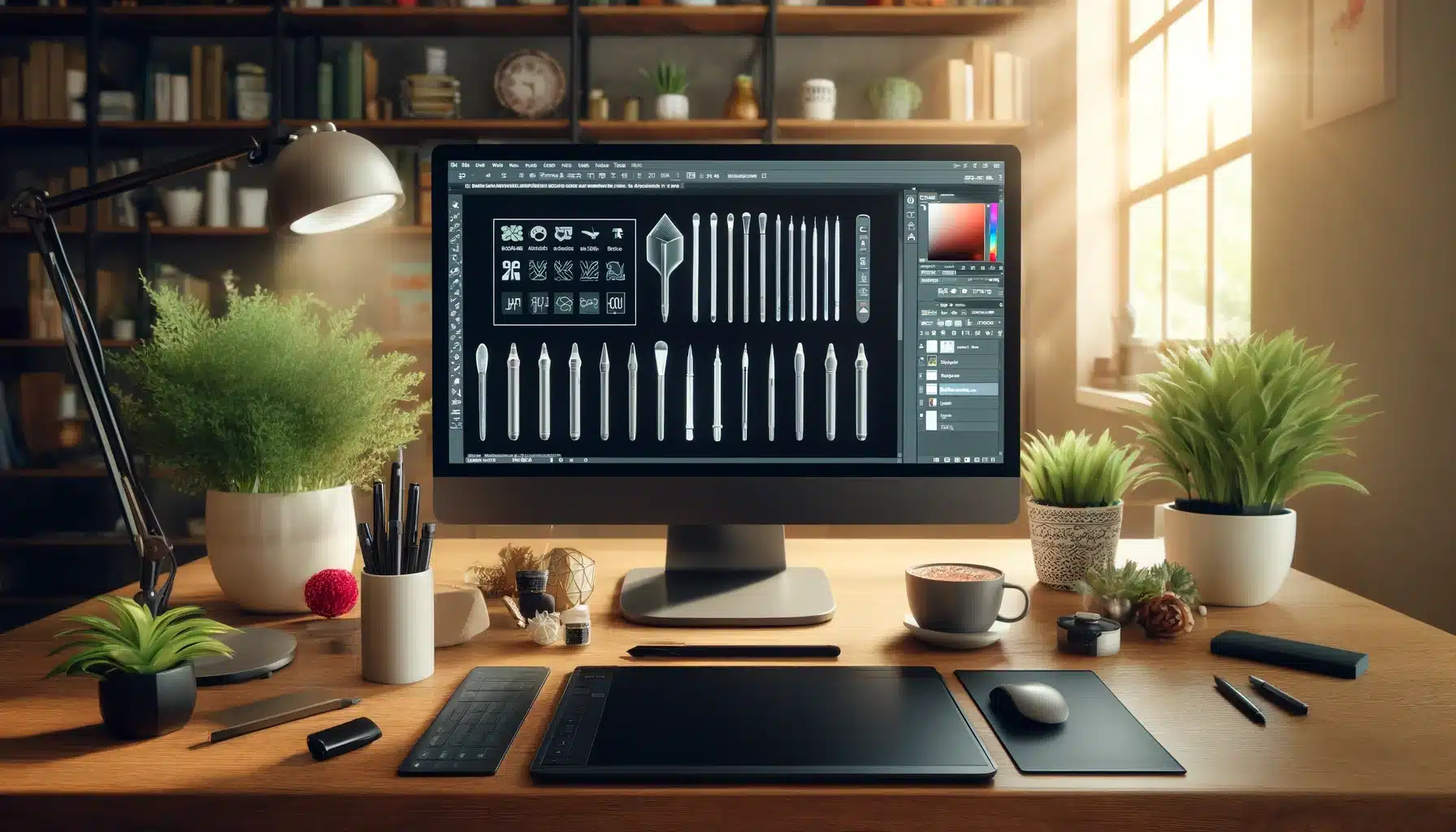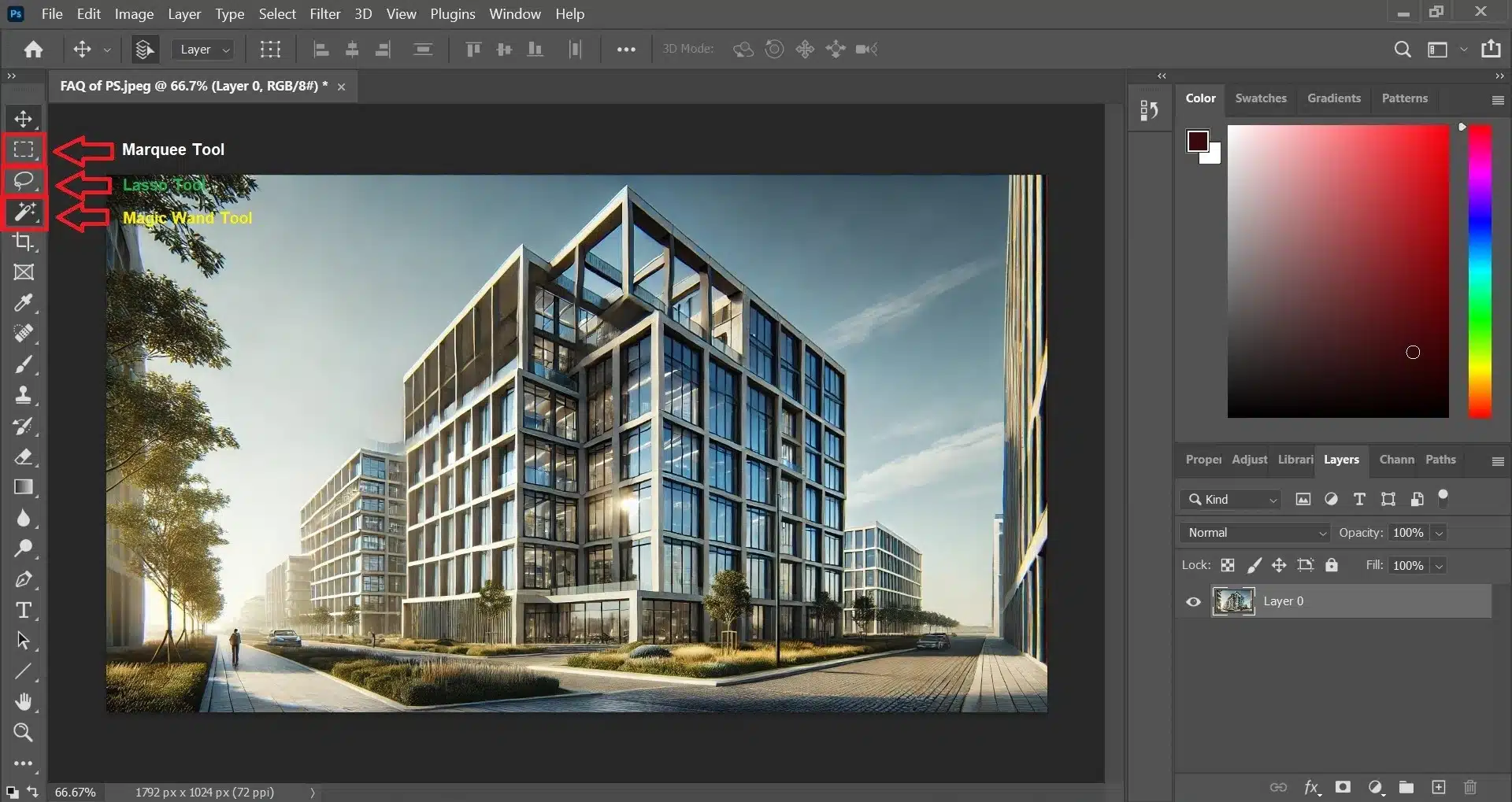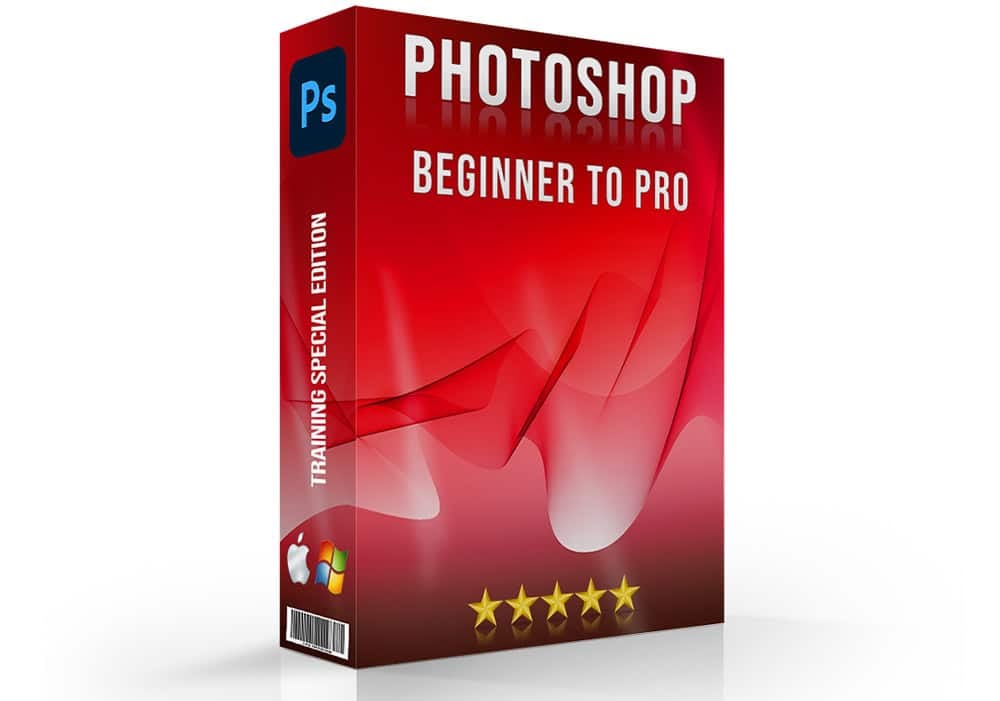
Introduction to the Quick Selection Tool in Photoshop
The Quick Selection Tool in Photoshop is magic at your fingertips. This amazing tool helps you select parts of an image quickly and easily. Imagine you want to change the color of a shirt in a photo. With just a few clicks and drags, this Photoshop selection tool understands what you’re trying to select. It’s like having a smart assistant right inside your software!
In this article, we’ll guide you through everything you need to know about using this auto-selection tool in Photoshop. You’ll learn how to start using the tool, how to make your selections better, and some neat tricks to speed up your editing process. Whether you’re touching up family photos or working on professional projects, this guide will make it easier and more fun.
Table of Contents
Basic Capabilities of the Photoshop Selection Tool

The quick selection tool in Photoshop is a powerful helper for anyone working with images. It uses a special brush to recognize and select parts of your image that look similar. This tool makes it easier to work on just the parts of the image you want to change without affecting the rest.
Select Based on Similarity
This tool is smart! It looks at the colors and textures in your image and selects areas that match. For example, if you want to replace the blue sky, the tool will try to select the rest of the sky. It’s great for grabbing large chunks of similar colors or textures without tracing every edge.
Adjustable Brush Size
You can change the brush size to fit your selection area. A bigger brush grabs more area at once, which is perfect for big spaces like skies or walls. A smaller brush is great for detailed work, like selecting flowers in a field or buttons on a shirt.
Add or Subtract from Your Selection
Sometimes, you might grab a bit too much or miss a spot. No problem! You can add more to your selection by just clicking and dragging over the missed area. If you selected too much, you can remove the extra parts just as easily. This helps you get the exact selection you want.
Layer-Specific Selection
Layers in Photoshop are like sheets of glass stacked on top of each other, and you can work on each sheet without messing up the others. The selection tool allows you to select and edit areas on one layer without changing anything on the other layers. This is super helpful when your image has many different elements separated onto different layers.
Non-Destructive Editing
When you use the selection tool with layers, you don’t have to worry about ruining your original image. You can make a mask with your selection, which lets you change colors, adjust brightness, and more—without any permanent changes. If you don’t like your edits, you can just remove the mask and start over.
Step-by-Step Guide: How to Use the Quick Selection Tool in Photoshop
Using the selection tool in Photoshop can make editing your photos fun and easy. If you’re new to editing or just need to make a quick fix, this tool is super handy. Now, let’s walk through how to use this awesome tool so you can start making your photos look amazing!
Open Photoshop and Your Image
Begin by launching Photoshop on your computer. To open the image you want to edit, click on ‘File’ in the upper menu and then choose ‘Open’ from the dropdown. Now browse through the window and select your image.
Find the Quick Selection Tool
On the left toolbar, look for an icon resembling a paintbrush with a dotted circle. If you don’t see it, it might be hidden under the Magic Wand Tool. Just click and keep holding on the Magic Wand Tool until you see other options and pick the selection tool.
Prepare Your Workspace
Make sure you have a clear view of the image. Adjust your view by zooming in or out to focus on the details more clearly. For Windows, use ‘Ctrl’ plus ‘+’ to zoom in and ‘Ctrl’ plus ‘-‘ to zoom out. Mac users should use ‘Cmd’ plus ‘+’ to zoom in and ‘Cmd’ plus ‘-‘ to zoom out.
Customize the Tool Size
At the top of your screen, you will find options to change the tool size. Use a larger setting for selecting big sections like backgrounds, and a smaller setting for more precise parts such as edges or small features. Adjust according to the part of the image you need to work on.
Click and Drag to Make Your Selection
Position your cursor over the part of the image you want to modify, then click and drag. The tool will automatically detect areas with similar textures and hues. As you drag, the tool will make the selection helping you isolate parts of the image you want to work on.
Modify Your Selection
If the selection isn’t perfect on the first try, you can fine-tune it. Use the ‘Add to selection’ option to include more areas or ‘Subtract from selection’ to remove unwanted parts. Simply click on the specific parts until it meets your needs.
Open the Refine Edge Window
After you are satisfied with your selection, click on ‘Select and Mask’ at the top. This action opens a new dialog where you can make your edges smoother and more natural-looking. This step is crucial to ensure your selection blends naturally with the rest of the image or stands out distinctly, depending on your project needs.
Adjust the Edge Settings
In the ‘Select and Mask’ dialog, you will find several sliders for edge adjustments. The ‘Smooth’ slider reduces jagged edges making the transition smoother. The ‘Feather’ option blurs them gently for a seamless transition, and ‘Contrast’ sharpens the edges for a more defined boundary.
Preview and Apply
Always preview your changes to make sure they look right. You can see the preview on different backgrounds or as a black-and-white mask. When you’re satisfied, click ‘OK’ to apply your changes.
Key Shortcuts for the Photoshop Quick Selection Tool

Keyboard Shortcuts are great for efficient selection in Photoshop using the quick selection tool. They help you make changes quickly without needing to click through menus. Here’s a detailed look at some important shortcuts that you can use to better manage your photo edits with this tool.
| Shortcut Key (For Windows / For Mac) | Function |
|---|---|
| [ and ] | These keys let you change the tool’s diameter to better fit the part of the image. Press “[” to make it smaller for precise areas or “]”to make it bigger for larger sections. |
| Shift + Click | This combination allows you to increase your selection. It’s useful when you want to add more parts of your photo to your current selection. |
| Alt + Click / Option + Click | Use this to reduce your selection. It helps remove parts you didn’t mean to include, making it more accurate. |
| Ctrl + Z / Cmd + Z | Press these keys to undo your last action. It’s perfect for fixing editing mistakes. |
| Shift + Drag | If you drag while holding Shift, you can smoothly expand the selection to include adjacent similar areas without restarting. |
| Alt + Drag / Option + Drag | Dragging while holding Alt (Option on Mac) lets you smoothly take away parts of your selection for finer control. |
| Ctrl + Alt + Z / Cmd + Option + Z | This shortcut lets you undo multiple steps one by one. It’s helpful when you need to go back several changes. |
| Ctrl + D / Cmd + D | This quickly clears any selection you have active. It’s a great way to start fresh on another part of the image. |
Using the Photoshop Selection Tools for Specific Projects
The quick selection tool in Photoshop is incredibly useful for specific types of projects where precise edits are necessary. Understanding how to use this tool effectively can greatly enhance the outcome of your creative work.
Creating Composite Images
If you want to make a picture that combines parts of different photos, this tool is very helpful. You can quickly pick out people or objects from one photo and put them into another scene. For instance, imagine taking a person from a beach photo and placing them into a city scene. The quick selection tool makes it easy to grab just the person without any of the beach background.
Improving Product Photos
For product photography, presenting a clean and clear image of your product is essential. The quick selection tool makes it easy to pick out a product and change things like the background or the colors. This makes the product stand out and look great for selling online.
Editing Portraits
In portrait editing, making subtle adjustments can significantly improve the final image. The Photoshop selection tool can be used to choose specific parts of the face, like eyes or teeth. For instance, brightening the eyes or adjusting the hair color becomes much simpler. This can make the portrait look nicer.
Removing Unwanted Backgrounds
Sometimes you need to remove a busy or unwanted background from a photo. This selection tool can select the object quickly so you can remove the rest. This is great for cleaning up snapshots or preparing images for graphics and presentations. Learning how to crop in Photoshop is an essential skill, acting as your gateway to the vast world of possibilities
Photoshop Selection Tool Settings Explained
The quick selection tool in Photoshop comes with several settings that can be adjusted to enhance its performance and adaptability to various editing tasks. Understanding these settings can help you use the tool more effectively. Here’s a simple table explaining the main settings of this creative tool and what each setting does.
| Setting Name | Description | Impact on Use |
|---|---|---|
| Brush Size | Modifies the diameter of the tool’s circle. | Bigger size covers more area quickly; smaller size offers more precision. |
| Hardness | Dictates the softness of the tool’s edges. | Softer edges blend better, harder edges create a more defined boundary. |
| Sample All Layers | Lets the tool consider information from all visible layers in the selection. | Useful for maintaining consistency across multiple layers without merging them. |
| Auto-Enhance | Automatically refines the edge of the selection for smoother results. | Enhances accuracy, especially in complex parts with mixed colors and textures. |
| New Selection | Starts a new selection, disregarding previous selections. | Clears existing selections, allowing you to start fresh. |
| Add to Selection | Adds newly selected parts to the existing selection. | Expands the scope of the selection without losing prior selections. |
| Subtract from Selection | Removes areas from the existing selection. | Refines the selection by removing unwanted parts. |
| Mode | Simplifies the tool’s interface and options for faster selections. | Streamlines the selection process, ideal for quick edits or when working under time constraints. |
| Continuous Mode | Keeps the tool active for continuous adjustment as you drag across the subject. | Facilitates ongoing adjustments to the selection, ideal for objects with complex outlines or mixed backgrounds. |
Creative Uses of the Quick Selection Tool in Digital Art
The quick selection tool in Photoshop is not just for simple edits; it opens up a world of creative possibilities in digital art. By enabling precise selections, artists can push the boundaries of their creativity.
Enhancing Textural Details
Digital artists can change textures in their art with this tool. For example, if an artist is working on a picture of a forest, they can easily make the tree bark look rougher or the leaves shinier. This adds life and realism to the artwork.
Manipulating Light and Shadow
In digital art, controlling light and shadow can dramatically affect the mood and depth of an artwork. Using this Photoshop selection tool, artists can select areas where light or shadow should be stronger or softer. This can evoke emotions in the artwork, like making a sunset more dramatic or a room cozier.
Designing Unique Patterns
Artists can also create unique patterns using the quick selection tool. By selecting and duplicating parts of an image, they can design intricate patterns that can be used in larger designs or as standalone art pieces. This technique allows for high levels of creativity and customization, as artists can mix and match different elements to produce truly one-of-a-kind designs.
Comparing Quick Selection with Other Photoshop Selection Tools

In Adobe Photoshop, different editing tools are designed to help you select parts of your images. Below, we compare the quick selection tool with other common tools in Photoshop, highlighting their main differences and best uses.
| Tool Name | How It Works | Best Use Case |
|---|---|---|
| Quick Selection | Automatically detects and selects similar colors and textures. | Great for fast and rough selections where precision is less critical. |
| Magic Wand | Selects all parts of an image that share the same or similar fill color. | Useful when you need to select large parts of similar color with one click. |
| Lasso | Freehand selection tool that lets you draw around the object you want to select. | Ideal for custom selections, where you want to outline the area manually. |
| Polygonal Lasso | Allows you to make selections using straight lines by clicking around the object. | Best for objects with straight edges. |
| Magnetic Lasso | Automatically clings to the edges of contrasting objects as you click along their borders. | Useful for objects with complex, high-contrast edges against varied backgrounds. |
| Marquee | Rectangular or elliptical tools for selecting squares, rectangles, circles, and ovals. | Perfect for geometric shapes and uniform selections. |
Pro Tip: Familiarize yourself with the smart selection in Photoshop in order to know which tool to use in which situation.
Advanced Techniques and Tips for Photoshop Selection Tool
Mastering the quick selection tool in Photoshop opens up many possibilities for refining and perfecting your photo edits. This tool is not just for simple selections; with a few advanced techniques, you can tackle complex editing tasks with ease and precision.
Integrating with Other Selection Tools
Combining the quick selection tool with other selection tools in Photoshop enhances its utility. For example, the Lasso Tool helps fix little mistakes the selection tool might miss, especially in detailed spots. The Marquee Tool is good for fixing straight lines that got selected by mistake. This helps you make sure only the parts you want are selected.
Pro Tip: Familiarize Lightroom’s selection tools as well to further enhance your skillset.
Utilizing Adjustment Layers
Adjustment layers are really helpful because they let you change your photo without messing up the original. Just select the part you want to change with the quick selection tool, then add an adjustment layer. This way, you can tweak colors or brightness only on the selected part, and you can always remove or change it later.
Refine Edge Feature
The Refine Edge feature is a great trick for more professional photo editing. After making the initial outline, you can use Refine Edge to smooth out the rough edges. This makes your selection look more natural, especially if you’re working with tricky parts like hair or fur.
Advanced Color and Texture Matching
Another advanced technique involves adjusting the tool’s sensitivity to colors and textures. If you’re working in an area with lots of similar colors, adjusting the tolerance lets you control how much the tool picks up. This means it won’t grab too much or too little of what you’re trying to select.
Background eraser mode
Lastly, using the background eraser mode with the quick selection tool can dramatically improve how well the tool separates foreground elements from their backgrounds. It allows you to erase similar colors directly around the selection. This helps to isolate the subject more cleanly when the background is distracting.

Commonly Asked Questions about Quick Selection Tool in Photoshop
The selection tool in Photoshop is a favorite among both novice and professional editors due to its simplicity and effectiveness. Here we address some commonly asked questions about this tool, providing clear and practical answers.
What is quick selection in Photoshop?
The Quick Selection tool is designed to help you easily select specific parts of an image. It automatically detects and follows the edges within the area you click and drag over. This tool is especially useful for quickly edit or remove objects like people or items without affecting the rest of the image.
How to use quick selection tool in Photoshop to remove background?
To remove a background using the Quick Selection tool, first select the tool from the toolbar and use it to click and drag around the object you want to keep. The tool will select the object, and you can then invert the selection by going to ‘Select’ and choosing ‘Inverse’. This action selects the background instead of the object. Finally, hit the ‘Delete’ key to remove the selected background, leaving only your object.
What is the use of a selection tool in Photoshop?
A Photoshop selection tool is essential for editing specific parts of an image without altering the entire picture. These tools allow you to isolate areas, enabling you to apply effects, adjust colors, or selectively remove elements. This functionality is crucial for detailed image editing and creative modifications.
Where is the quick selection tool in Photoshop?
In Photoshop, the quick selection tool can be found on the main toolbar, typically located on the left side of the screen. Look for an icon that resembles a paintbrush with a dotted circle around its tip. This tool is often grouped with similar tools, so you might need to click and hold a related tool icon to find it.
Conclusion
As someone who often uses Photoshop for various projects, I’ve found the Quick Selection Tool in Photoshop incredibly helpful. Just last week, I was working on a photo montage for a family reunion, and this tool made it super easy to pick out each family member from different photos and bring them all together into one beautiful scene. This tool is a real game-changer for anyone looking to streamline their photo editing process.
If you want to dive deeper and truly master the Photoshop selection tools, why not check out our comprehensive courses? We offer specialized Photoshop course and Lightroom courses that can take your skills to the next level.
Have a nice photoshoot!
Learn more about Photo Editing with Lightroom and Photoshop:

















